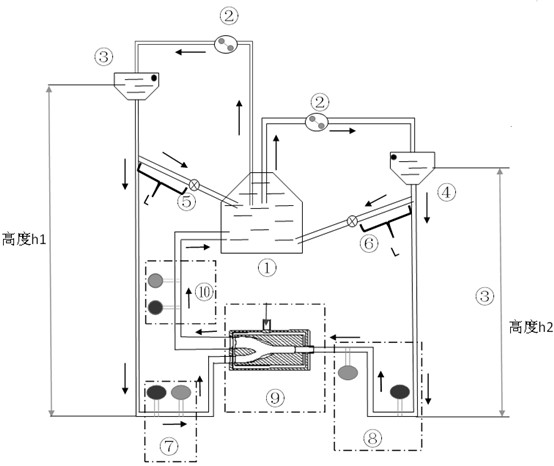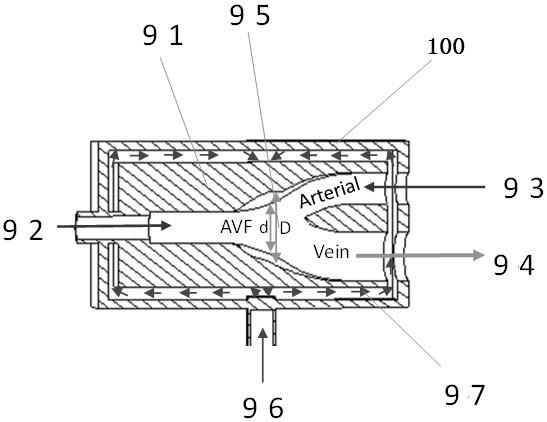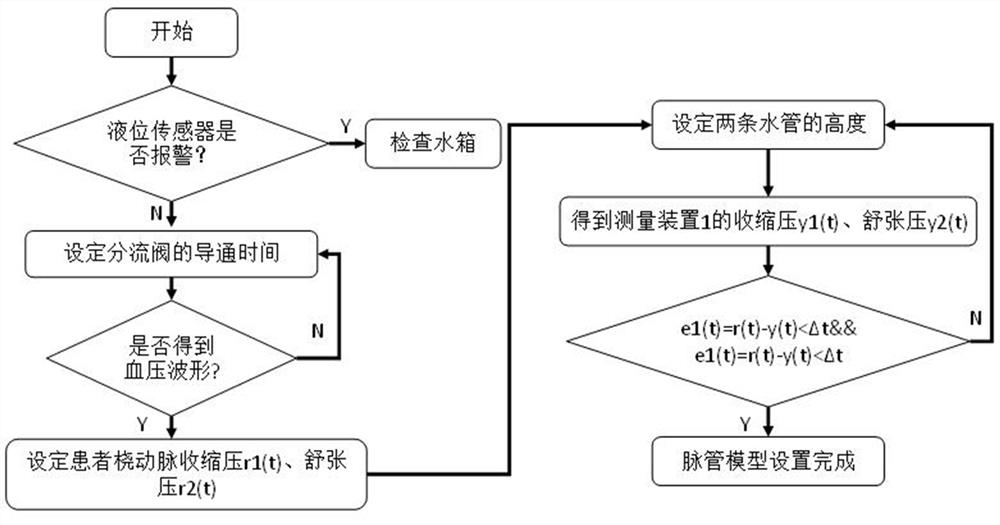Arteriovenous fistula in-vitro hemodynamic physical simulation model device
An arteriovenous fistula and fluid dynamics technology, applied in the field of simulation, can solve problems such as long experimental period and inconsistent results
- Summary
- Abstract
- Description
- Claims
- Application Information
AI Technical Summary
Problems solved by technology
Method used
Image
Examples
Embodiment 1
[0058] In this example, the simulated blood is mixed glycerol water (38%-62% by volume) liquid. At 28°C, the viscosity is 3.2×10 -6 m 2 / s, and the density is 1090 kg / m 3 .
[0059] The overall structure of the model in this example is as follows figure 1 As shown, the model contains water storage tank 1 (simulating heart container 1) to simulate the heart as the source of inflow and outflow of blood, and water pump 2 transmits blood to funnels 3 and 4 containing liquid level sensors (radial artery blood pressure simulation container 3, head Venous blood pressure simulation container 4), according to the blood pressure of the radial artery and cephalic vein of the patient, the systolic pressure of the blood pressure is converted from the unit of mmHg to bar. Place the funnels 3 and 4 at different heights h1 and h2, respectively, in the funnels 3 and 4 When the liquid level sensor is lower than a certain value, it will drive the corresponding pump to act. When the liquid le...
Embodiment 2
[0061] Further, in Example 1, different mixing ratios are used to make silicone models with different elasticity, the size of the skin is 15*15*8mm, and the measurement is performed with a universal testing machine to select the skin that is closest to the skin parameters reported in the literature mold. A cross-sectional view of the fistula end-to-side coupling is shown in figure 2 As shown, the two main pipelines (92-radial artery simulated input tube; 93-capillary simulated input blood vessel) respectively flow to the radial artery inlet and capillary inlet of the fistula simulator 9 simulating the skin, in the model of the fistula simulator 9 , the cephalic vein simulated output tube 94 vein outlet is provided at the simulated skin, the cephalic vein 94 and the radial artery 92 form an arteriovenous fistula 95, the blood vessels are placed in the elastic silica gel of the simulated skin 91, and the whole artificial skin is placed in a 20*20* In the airtight iron box 100 ...
Embodiment 3
[0063] Further, the human body vessel model setting process in Example 2 is as follows image 3 As shown, the two water pipes are placed at a certain height before the model starts to work. This height is obtained after unit conversion based on the systolic pressure of the radial artery and cephalic vein before the fistula is constructed. The next two are to check the water storage tank 1 Whether the water in the water is enough to fill the water pipes in this model, whether the liquid level sensors 3 and 4 will alarm and trigger the pump to work, and then set the respective conduction times of the two diverter valves 5 and 6, which are determined by measuring Devices 7 and 8 measure the pressure and flow rate, and observe whether the waveform of the blood pressure is close to the normal waveform. If yes, proceed to the next step; otherwise, adjust the on-time until the Figure 4 results so far.
[0064] Then set the systolic blood pressure and diastolic blood pressure of the...
PUM
 Login to View More
Login to View More Abstract
Description
Claims
Application Information
 Login to View More
Login to View More - R&D
- Intellectual Property
- Life Sciences
- Materials
- Tech Scout
- Unparalleled Data Quality
- Higher Quality Content
- 60% Fewer Hallucinations
Browse by: Latest US Patents, China's latest patents, Technical Efficacy Thesaurus, Application Domain, Technology Topic, Popular Technical Reports.
© 2025 PatSnap. All rights reserved.Legal|Privacy policy|Modern Slavery Act Transparency Statement|Sitemap|About US| Contact US: help@patsnap.com



